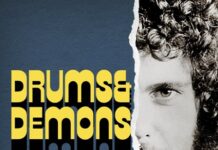Following the 2021 publication of their official Emerson, Lake & Palmer book, London-based publisher Rocket 88 has rolled out Keith Emerson: The Official Illustrated Story, a highly personal, introspective tome written by veteran British rock journalist (and one of the few who supported ELP) Chris Welch. There are tons of juicy stories and recollections from the musician’s family members, friends, peers, and collaborators. Plus, this hardcover beauty is loaded up with oodles of previously unpublished photos to keep your eyes tapping while your brain follows the storyline.
The book is a mixture of photos, pull quotes from the interviews Welch did, and little bits of facts and figures to tie the whole story together. It’s cleverly divided into six movements — Scherzo, Allegro, Concerto, Symphony, Fugue and Anthem — as if to underscore the point that changes one experiences in life often simulate the working parts of a classical piece of music. For a man who aspired to become a composer whose name would one day be uttered in the same breath as Aaron Copeland, George Gershwin and Irving Berlin, the format couldn’t be more suitable.
From a modest, yet musical upbringing in a small parish town in the middle of England, to the clubs of London, then on with the Nice, followed by the massive success of Emerson, Lake & Palmer, and everything that came after — it’s all touched on and discussed. Mandy Chapman, Emerson’s cousin, fills in the blanks about his formative years. We find out that Emerson’s father was also a musician, Chapman’s mother’s dance classes were where her young nephew learned how to improvise, and that most of everyone in the family was supportive of young Keith Emerson’s musical ambitions.
Once Emerson goes pro, things shift and escalate rather quickly. With the Nice, he soon became known as a showman behind the Hammond. The band’s bass player, Lee Jackson, along with Yes members Alan White, Rick Wakeman, Steve Howe, and Geoff Downes all regale us with tales about the days of the Nice and the wild keyboardist who’d somehow transformed his role and brought the instrument to the frontline. We also meet Emerson’s one and only wife, Eleanor, who became acquainted with the musician in 1969. They married in 1970 and stayed together for the next 26 years.
It’s a shame Greg Lake, who passed away just months after Emerson in 2016, wasn’t able to be a part of this book. Most of the insight on ELP comes from the last man standing — drummer Carl Palmer. If you read both Emerson and Lake’s memoirs, you get a feel for the sometimes contentious, yet always complementary bond the two had with one another. Here, from Palmer’s point of view, it’s really more about the sweat, dedication and hard work put into the group, and how much of a pioneer Emerson was during a period when ELP became one of the biggest bands on the planet.
More feedback from the Yes camp, along with manager Stewart Young, personal assistant Andrew Lane, and roadie Peter “Rocky” Morley, certainly attest to Emerson’s discipline, perseverance, and drive to take risks, both on and off stage. It’s not surprising that the Concerto movement is the longest.
For the Symphony movement, the focus turns to Emerson’s domestic life with his wife, children, grandchildren and friends — all of whom pipe in with memories of the maestro. Along the way, we learn about a fire at Emerson’s Stonehill household that would have an enormous effect on the master’s mental psyche. Loving musings from Emerson’s sons, Aaron and Damon, daughter-in-law Jo, grandson Ethan and friend Jim Davidson, leads to 2006 when two things happened: Emerson and Wakeman talk about working together (but never did), and meeting Mari Kawaguchi, the keyboardist’s girlfriend until the very end.
Activities in the 80s, 90s and 00s may not measure up to the excitement and glamor of ELP, but those who worked and knew Emerson during those years can’t say enough good things about him. Musicians he played with then like Robert Berry, Jeff “Skunk” Baxter, Dave Kilminster, and Marc Bonilla all remember Emerson with great fondness and admiration. Things eventually wind down with the ELP High Voltage reunion of 2010 and circumstances around Emerson’s declining playing ability, due to various medical and health-related issues.
Even as the accolades poured in, Keith Emerson struggled both physically and mentally with not being able to play at the level he once could. News of his unfortunate suicide in 2016 affected his family, friends, colleagues and fans with great sadness. While those closest to him try to explain his purported state of mind, they simultaneously share the pain of his loss.
The final thoughts that fill the Anthem movement may well do Emerson the most justice. Regina Lake, Greg Lake’s wife, shares a particularly poignant moment when her husband and the keyboardist were rehearsing together prior to the ELP reunion. There’s no need to share the details here, but suffice to say, it’s a nice way to sum up the working and personal relationship between Keith Emerson and Greg Lake, which lasted nearly to the end of both their lives.
Closing the book, you not only get a clear sense of Keith Emerson the great keyboard wizard of the Nice and ELP, you also get a feel for his humanity, humor, humbleness, wit, spirit, fearlessness and love of everything and everyone near and dear to him. Fans, observers and admirers alike will find something to cherish and think about after reading either deluxe edition — the Classic and the Signature — of Keith Emerson: The Official Illustrated Story.
~ Shawn Perry




















